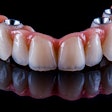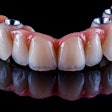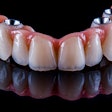Use of short dental implants in some patients could help avoid major surgeries, save time, reduce costs, and eliminate possible complications associated with grafting procedures, a Swiss researcher reported today at the 27th Annual Meeting of the Academy of Osseointegration (AO) in Phoenix, AZ.
"In cases with a reduced ridge height in the posterior maxilla, sinus grafting in combination with implant placement is the treatment of choice," explained Daniel S. Thoma, DMD, of Zurich, Switzerland. "Sinus grafting is associated with an increased risk for implant failures and patient morbidity."
Dr. Thoma reported the results of a randomized, controlled, multicenter study comparing short implants (6 mm) to standard-length implants (11 to 15 mm) with sinus grafting. All 100 patients in the study had their implants placed, and entered the follow-up phase with loading at one year. No implants were lost, resulting in a 100% implant survival rate in both treatment groups.
"Based on these preliminary findings, both treatment modalities were safe and predictable. This was demonstrated by a 100% implant survival rate, the absence of biological complications, and only one minor technical complication," Dr. Thoma reported.
Provided that short implants perform similar to longer implants with major augmentative surgeries on the long-run, in the future, treatment concepts will likely change towards less and shorter implants resulting in a variety of benefits for clinicians and patients, he added.



















